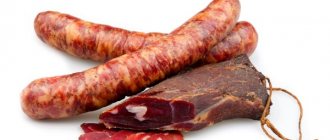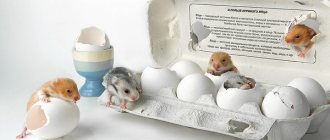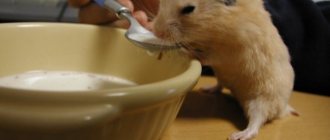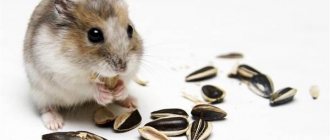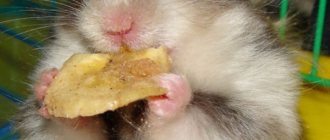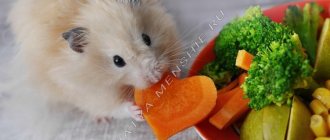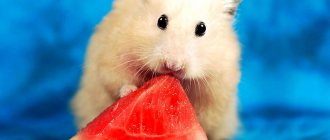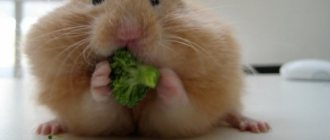Pet owners often wonder about their nutrition. The same applies to hamster owners. Pet store food usually consists of grains, since grains are a very nutritious food. This is where questions arise about whether hamsters can eat meat, and not just plant foods. Hamsters can and do love to eat meat, but they can’t eat everything. Let's consider what kind of meat can be fed to domestic rodents.
Proper diet
In the wild, a hamster's diet is determined by its habitat.
They often settle near fields and their main food is grain crops. Living next to hamsters causes a lot of trouble not only for agronomists. In search of food, they raid the houses of villagers. They extract the missing vitamins from juicy grass, leaves, vegetables and fruits. In addition to plant products, they feed on worms, caterpillars, beetles and spiders, which are a source of protein, and do not disdain the meat of wounded other small animals.
The owner needs to carefully consider the diet to maintain normal levels of macro and microelements.
How often and how much to feed
When planning a diet, the owner should take into account that hamsters are predominantly nocturnal; it is best to feed them 2 times a day.
The volume of finished food is 2/3 of the weight, with most of it given at night. This meal is considered breakfast, and the rest is in the morning, before a long sleep.
If the owner constantly sees an empty bowl, there is no need to worry that the pet is suffering from a lack of food. They make strategic reserves out of it. They hide everything that is not eaten during the day in their pantry for a rainy day.
When tidying up the cage, it is important to check every corner. You should carefully select perishable products from hidden items to avoid poisoning.
Weak and old hamsters require special attention; they exhibit lethargy and problems eating solid food. It is better to leave grain feed as the basis in the diet, so as not to cause digestive upset. Additionally, the seeds must be sprouted, and nuts and fruits must be ground on a grater or in a meat grinder.
Alternation of feed and products
The basis of the daily diet is grain crops, which can be purchased in the form of a balanced dry mixture. Their composition takes into account the necessary complex of fats, proteins, minerals, carbohydrates and vitamins. You can also mix them yourself, based on your preferences.
Hamsters respond positively to the inclusion of vegetables, fruits and fresh herbs in their daily menu. Due to the fact that hamsters are reluctant to drink plain water, succulent food is offered daily.
As a protein component, 2-3 times a week, choose one product from the list:
- boiled chicken meat without salt;
- hard-boiled chicken or quail egg;
- mealworms or earthworms;
- dried insects.
Can hamsters have sausage and frankfurters?
The hamster's body is very sensitive to food, regardless of the type of animal. The Djungarian hamster and the Syrian hamster are the most common types of domestic rodents. They differ from each other in size, but their diet is the same, which means the Syrian can suffer in the same way from harmful food as the Djungarian.
Sausages and frankfurters are processed meats. This product contains a huge amount of fat, spices, salt, not to mention preservatives, dyes and so on.
A rodent’s stomach simply cannot process such a composition. Therefore, it is impossible to give sausage to hamsters, and even strictly prohibited, since the pet may not refuse such a treat, but the consequences for its health will be more than terrible.
Hamster food
Hamsters' diet should not be limited to cereals and fruits. Pet stores have a large variety of foods for pet hamsters, but not all of these foods may be beneficial for your little friend. A couple of signs that the food is not suitable for feeding hamsters:
- It is important to first inspect the packaging. It must be sealed and not damaged. If it does not meet this requirement, then moisture may get into the feed, thereby creating the possibility of rotting. Compound. The diet should not contain a large amount of seeds, any foreign fruits or vegetables, or a high ratio of dried chicken or fish. Also, the composition should not contain a lot of fat and the food should not contain prohibited ingredients.
- Food for hamsters can be either universal or for a specific type of hamster. When choosing food, it is important to take this fact into account, because the diet may not have enough or an excess of the vitamins that your pet needs.
Can a hamster eat meat?
Hamsters eat meat very well. It is needed to replenish protein in the body. The amount depends on the age of the individual. If the hamster is young, it needs to grow and develop. For muscle growth, you need proteins, which are abundant in meat. The portion will depend on the weight of the pet. Oddly enough, this small rodent can eat food weighing 70% of its own body. The amount eaten in one go depends on the health and mood of the animal, since everything else will be drawn to the pantry.
So can hamsters have meat, or is it better not to? Necessary. Without fail, in small portions and rarely. But not every one of which you use in your diet. As you know, everything fatty and salty is harmful to them. And our homemade meat is rarely different after cooking. Therefore, give only unsalted meat and fish. But not in its raw form. You can also add cheese (unsalted, not fatty), a boiled egg, some food insects, and larvae to the diet. But remember, not every pet will eat insects; some may even be afraid of them. But they won’t refuse boiled chicken. This food should not be included in your daily diet. It is best to feed your hamster meat and other listed foods once or twice a month. But don't give pork. It can be harmful because it often causes stomach upset in pets. During pregnancy, you need to add more foods that contain calcium and protein to your diet. Therefore, more meat can be given to the hamster during this period. And also greens, cottage cheese, cereals. It is recommended for vitamin E deficiency, B2, B6 deficiency. Rice and buckwheat will be beneficial for your hamster.
I hope you remember that these rodents take everything they haven’t eaten into their pantry. Meat products in warm places spoil quickly and can eventually spoil everything nearby. Therefore, make sure that your pet does not leave any residue of this product there. Give just enough so that he can easily eat it all in one go.
We advise you to find out whether a hamster can eat cookies, because they also eat very different things.
Conclusion
Can hamsters eat meat? It will bring a lot of benefits to this animal if you do not use it often. Once or twice a month. Chicken will be very useful. But you should absolutely not give pork, so as not to cause stomach problems. Better give meat soups. Meat meal will also be nutritious. It contains a large amount of protein (about 50%). But remember, the amount of fat can reach 18%, so give no more than 2-3% of the hamster’s total diet.
What to feed a pregnant female?
Gestation of babies in hamsters lasts up to 20 days. During this period, the female should receive the maximum amount of useful microelements. The daily menu of a pregnant pet must include as many high-protein foods as possible, fresh herbs and cereal sprouts, which contain many nutrients. The expectant mother eats with appetite and gets very worried when there is little food in her feeder. Therefore, it is advisable to pour as much food into the bowl as possible. It is recommended to place a piece of chalk or a mineral stone in the cage, which is sold at any pet store. The female will nibble on the treat and receive the salts and minerals needed by the cubs developing in the womb.
What does it taste like
The delicious crustacean meat looks like a coagulated protein mass and vaguely resembles a salty boiled fillet of white ocean fish. Only it is more elastic in appearance and delicate in taste.
When raw, crab meat is a jelly-like mass that, when heated, coagulates like egg white. This is due to the presence of a large amount of animal protein in its meat mass.
According to the stories of experienced crab fishermen, the taste of the crab product largely depends on what part of the animal it is taken from and how the delicacy is prepared. Experts consider the “shoulder”, or the place where the limb meets the body, to be the most delicious and tender (melts in your mouth) part of the crab. This part is called the “rose”, the name of which is found in the labeling of some crab products.
Cooking secrets that affect taste
There are some interesting nuances to consider when it comes to cooking crustacean meat.
- For example, it is recommended to boil Kamchatka crab only in sea water, and under no circumstances in fresh water. Crab catchers explain that when boiled in sea water, the amount of iodine and other useful elements inherent in nature is preserved in crabs, for which this product is valued. Fresh water “pulls out” all these useful components from the meat of a marine animal.
- Another warning from crab catchers is that you should not freeze crustaceans without prior heat treatment. Since crab flesh has a jelly-like structure when raw, when quickly frozen, this mass spreads and sticks to the walls of the shell.
Crab legs cooked after being frozen raw may end up empty.
Imitation meat
The imitation product is made on the basis of a protein extract from minced fish (surimi), so the taste is almost no different from crab sticks.
According to reviews, both meat and crab sticks containing real crab are more tender and juicy, but experts believe that this is due to the peculiarities of the cooking technology.
Flavor enhancers and moisture-retaining substances are added to both crab meat and sticks. The more successful the combination of these ingredients, the tastier the final product.
Can Syrian hamsters eat tomatoes?
Regardless of what kind of hamster you have, there are general and unchanged principles for creating a diet. It is based on dry and wet food. Based on this, hamster breeders, veterinarians and breeding specialists have compiled a clear list of what can and cannot be given to hamsters.
DON'T (harmful to the body):
- Fried, sweet, fatty.
- Sugar.
- Salt.
- Spices.
- Cheese.
- Oil.
- Honey in its purest form.
- Fruit juices.
- Bread, rolls, pita bread, pretzels and other baked goods.
- Cookies, kozinaki, chocolate, ice cream.
- Sausages.
- Meat (except chicken), as well as offal (liver), especially processed into canned food or pates.
- Milk in any form, incl. porridge.
- Cream, sour cream.
- Egg yolk (undesirable).
- Pasta, especially dry ones.
- Food for other animals and birds.
- Drops for hamsters.
- Muesli.
- Citrus fruits (oranges, grapefruits, pomelo), exotic (kiwi, pomegranate, avocado, etc.).
- Garlic.
- Onion.
- Red beans.
- Radish.
- Almond.
- Apricot and cherry pits.
- Potatoes, potato skins, sprouts.
- Persimmon.
- Acorns.
- Sorrel.
- Watermelon.
- Cucumber, pepper and other greenhouse and foreign vegetables in the winter and spring.
- Cabbage.
- Eggplant.
- Tulip.
- Mushrooms.
- Rose hip.
- Mint.
- Coniferous branches (they are resinous).
- Any plants within the city.
- Bloodworm.
- Insects caught on the street or in the forest.
NEEDED (necessary for the body):
- Dry food for hamsters (ready-made, sold in pet stores).
- Wet food - apple, pumpkin, carrot, non-winter bell pepper, non-winter cucumber and tomato, radish (a little), zucchini, zucchini, squash, beets, turnip, pear, peach, apricot, melon, banana (chips - rarely), grapes, corn, green beans, Chinese salad, broccoli (a little), frozen vegetables (mixed and separately), plums (a little), fresh peas, soaked chickpeas and sprouted mung bean, young green peas, Jerusalem artichoke. And also vegetables boiled without salt - carrots, pumpkin, peas, beets.
- Frozen “Mexican mixture” (without onions) - pour over boiling water or cook (the most delicious are peas, corn, green beans).
- Seeds – pumpkin, melon, sunflower.
- Nuts - hazelnuts, walnuts, peanuts, chickpeas, cashews, peanuts, chickpeas. Give rarely, as a treat, because... they are fatty and harmful to the liver. Pine nuts are undesirable due to their very high fat content.
- Sprouts of oats, wheat, alfalfa.
- Cereals - barley, oatmeal, buckwheat, wheat, lentils, rolled oats, peas, beans.
- Berries – pitted cherries, strawberries, gooseberries, currants, blueberries.
- Dried fruits - dried apricots, raisins, dried pears and apples, banana chips (rarely).
- Greens - lettuce, dill, parsley, dandelion, clover, nettle (scalded), plantain.
- The branches of the trees are all deciduous, except for stone fruits and those growing within the city. Before use, boil for 20 minutes to ensure sterility.
- Pink petals (except those treated for pests).
- Dryers and homemade popcorn without fat, salt and sugar are like a treat.
IMPORTANT (protein supplement - one thing 2-3 times a week):
- Boiled chicken breast without salt and spices.
- Cottage cheese, kefir, yogurt without sugar, no more than 1% fat.
- Boiled egg white (chicken, quail).
- Boiled shrimp (meat, rare).
- Mealworms, butterflies, earthworms, grasshoppers (pet store only).
- Boiled fish – lean, boneless.
- Dried gammarus (from a pet store).
If the hamster is sick, or you need to feed the young animals, then the following products are prepared:
- Baby food . Vegetable and meat (without sugar, salt, gluten, soy).
- Porridge. Children's dairy-free low-allergenic porridge without salt, sugar and gluten. Porridge on the water. Cereals soaked in water.
- For diarrhea. Rice undercooked, but cooked to stickiness, and rice water.
- For constipation. Vaseline oil (2 drops every 3 hours until stool appears).
What foods should not be given to hamsters?
Spices: pepper, salt, cinnamon, vinegar - everything that we use as a food additive. That is why it is extremely undesirable to feed a hamster from a human table.
Fatty foods (sausages, fatty meats, cheeses, milk, lard, butter, heavy cream and sour cream), sweet foods (honey, sugar, jam, sweets), salty foods (canned vegetables, salted fish, etc.) are harmful to a hamster. , flour (bread, especially white, buns, cakes, pastries), spicy (dishes with pepper).
Fruit seeds are harmful and may even be toxic: peach, apricot, plum, cherry seeds. You should not give hamsters spruce, pine cones, or nuts in shells. With sharp edges, hamsters can damage their cheek pouches, and fruit tree seeds can cause poisoning.
It is not advisable to give your hamster spikelets with grains: the sharp edges of the spikelet can also prick the cheek pouches.
Peppermint treat
Ingredients:
- 1 medium overripe banana.
- 2 chicken eggs.
- 3 tbsp. spoons of honey.
- 3 tbsp. tablespoons of liquid coconut oil (can be replaced with sunflower oil in the same amount).
- 1/2 teaspoon mint flavoring.
- 1/2 teaspoon baking powder.
- A quarter cup of carob (roasted carob powder). A small amount of cocoa can be substituted, but this is not recommended for animals. Therefore, try to find an original product.
- Oat flour.
Cooking procedure.
1. Mash the banana in a bowl.
2. Beat eggs into the resulting mass, add honey, baking powder, cinnamon and coconut (sunflower) oil.
3. Add oatmeal to the mixture to form a firm but slightly moist dough.
4. Divide the resulting volume into 2 equal parts.
5. Pour 1/4 cup of carob powder into one half, and add the same amount of flour to the second half. A hard lump should form that does not stick to your hands.
6. Roll out 2 rectangles, 9-10 mm thick.
7. Place the layers of dough on top of each other and roll along the long side. Wrap the resulting sausage in plastic wrap and put it in the refrigerator overnight.
8. Preheat the oven to 180 degrees.
9. Cover a baking sheet with parchment paper.
10. Remove the film and cut into 3-3.5 cm rounds.
11. Place on a baking sheet. During cooking, portions of dough will not increase in volume, so you can place them close to each other.
12. Bake for 10-15 minutes.
If you want to please your pet with a crunchier treat, cut the rolls into thin slices (about 1 cm), and after cooking, additionally dry them in a warm oven or even in a non-stick frying pan.
The finished product is stored for a long time in a dry place. So, by baking peppermint rolls once, you can treat your four-legged pupil with them for a long time.
Bon appetit to your dog!
I like it I don't like it
Can hamsters eat chicken?
Chicken can be added to the diet of hamsters; it contains many vitamins and beneficial elements, including phosphorus and potassium. You should cook meat without spices or even salt. Hamsters gobble up boiled chicken by both cheeks. It is better to choose fillet, it does not contain cholesterol. Chicken liver is also suitable, it is also well digestible.
Pets should be fed twice in the morning and once in the evening. You need to do this at a certain time to form a habit.
Boiled chicken is especially useful for females who are expecting offspring. They require twice as much protein as a normal pet. This diet strengthens her immune system and helps her survive stress. Meat can also be replaced with boiled eggs; they contain a sufficient amount of protein.
Beef liver and heart will also be useful, as they improve blood composition. Don't forget about the broth; rodents love it. You can add fresh parsley or any herbs to it.
Fried delicacies are strictly prohibited. This is a high-calorie food that adversely affects the organs, especially the heart and liver. Obesity and passive behavior may occur. Don’t forget that after processing, food loses all its vitamins and becomes less healthy.
Fish in the diet of hamsters
Fish is very useful for rodents. It is a dietary delicacy with a high content of vitamins and iodine. Fish, like chicken, is very easy to cook. It needs to be boiled without spices and salt. You can also diversify the diet and add cod liver, which strengthens the immune system of hamsters.
To make your rodents' fur coat soft and silky, you can give them a drop of fish oil. The average dose for any type is one tablet per week.
It is better not to give crab sticks to your pets. They contain many chemicals that will not be good for your stomach.
Soft bag
Fabric carriers have been around for a long time, but their modern development has primarily affected the increase in the number of all kinds of windows, mesh and other little things. The cat will no longer sit in a dark bag, not much different from an ordinary travel bag. It is difficult to organize a comfortable long trip in such a device. But for short distances the convenience is quite adequate.
The advantage of a soft cage is its lightness, compactness, and the ability to securely attach it to a car seat or, for example, to the handle of a suitcase.
Negatives: Not hygienic for long trips and difficult to clean quickly (although they can withstand washing in a regular washing machine).
Cost – 1,360 – 1,489 rubles.
Can a hamster eat meat?
For normal development of hamsters, their diet must include protein. Its origin can be either plant, for example from legumes, or animal, from meat or eggs.
Hamsters can be given 1-2 times a week, but not more often:
- chicken – lean breast does not contain much cholesterol and is easier to digest;
- beef – helps strengthen the immune system and is an excellent prevention of vitamin deficiency;
- Beef liver is a dietary product with a high content of beneficial microelements and vitamins;
- beef heart - recommended for rehabilitation after illness, as it helps improve blood composition.
Meat should not be given without preliminary heat treatment, that is, raw, since it may contain various pathogenic bacteria and parasites. The product should be low-fat, well boiled without any spices or salt.
Basic nutrition of the Djungarian hamster
In nature, the Djungarian hamster's diet consists mainly of seeds and cereals. Therefore, it is reasonable to feed the dwarf at home according to the same principle.
The ideal option is to feed ready-made food for Djungarian hamsters. All the necessary grains, seeds, and dried herbs are already mixed there. Often the manufacturer enriches the feed with minerals, trace elements and vitamins.
This mixture can be given to dzhungarika constantly, periodically adding fresh vegetables, fruits and berries (in season), plus protein (more on that below). But if for some reason you cannot feed ready-made food, then here is a detailed video on the topic “how to prepare food yourself.”
What berries can you give?
Juicy seasonal berries should undoubtedly be present in a hamster's diet, because they are a rich source of a wide range of vitamins and minerals. Eating them helps keep the immune system in order; you are allowed to treat:
- wild forest rowan;
- blackberries;
- strawberries;
- blueberries;
- cranberries;
- strawberries;
- white and red currants.
In very limited quantities, the hamster is occasionally given the following berries:
- lingonberries;
- blueberries;
- chokeberry;
- ripe unsweetened grapes (seedless);
- pitted cherries and cherries;
- raspberries;
- gooseberry;
- black currants.
Conclusion
Thus, meat is an essential product in a hamster’s diet. The meat should be divided into small pieces and given to the pet in small portions.
Here is a general list of what hamsters can eat as protein food:
- boiled chicken (without salt and spices);
- boiled lean beef;
- boiled fish (without salt and spices);
- fish fat;
- fish liver;
- eggs;
- cottage cheese (no more than 1% fat content);
- baby meat puree.
https://youtube.com/watch?v=VwsMEEifIjA
The diet of hamsters should be supplemented with vegetables, fruits, herbs and protein products. But not all food is good for rodents.
Let's find out what you can feed your hamster at home, and what foods it is better to avoid.
- What does a hamster eat
- Grain mixtures
- Green food
- Vegetables and fruits
- Can hamsters eat meat?
- Vitamins and minerals
- How to make a hamster's diet
- What should you not give hamsters to eat?
What to feed the baby?
A small hamster has a very delicate digestive system, so it needs to be fed differently than an adult animal. A baby up to three months old eats often, but little by little. There should always be a dry grain mixture in the feeder, although many babies do not really like to feast on it. It is advisable to give your hamster one product per day from fresh greens, so as not to provoke intestinal upset. For the same reason, you should not treat him with exotic fruits. You can sprout lettuce, wheat, beans, and peas for the baby. Young shoots are easily digestible and rich in microelements necessary for the full growth and development of the animal. Regular baby food that combines meat, cereal and vegetable ingredients is well suited for a newborn animal. Baby porridge or puree is placed in a bowl and placed directly in the cage.
Conclusion
These tips are suitable for any type of rodent. Meat must be included in the diet of hamsters due to the large amount of protein in it. It is enough to give once a week. It must be boiled and be sure to cut into small pieces. Don't forget about drinking hamsters. There should always be a drinking bowl freely available in their house.
Meat should be alternated with other foods high in protein: eggs, fish or cottage cheese. Such supplements to the regular diet have a positive effect on the coat and the entire body, preventing vitamin deficiency (vitaminosis).
Do not forget about the hygiene and sanitary conditions of keeping your pet. If the hamster has not eaten the liver or fish, it is necessary to remove the waste from the house and dispose of it. Fish and other goods cannot be stored at room temperature for long. They deteriorate especially quickly in the summer.
Good day to all! My name is Masha and I really love animals. In today’s article I want to tell you about what you can and cannot feed your hamster (Djungarian and Syrian) besides store-bought food and treats!
Feeding your little friends is the basis for health and long life. If you think that a hamster eats everything, then you are mistaken! The rodent is unreasonable and it can really eat everything that the owner gives. And in most cases it can end badly
If the health of your hamster is important to you, it is better to find out in advance what you can and cannot give when keeping it at home!
The homeland of most hamsters is steppes and semi-deserts. Their esophagus is not able to digest fatty, sweet or high-calorie foods. In nature, the main food of hamsters are grains and seeds. In the spring they eat green grass and closer to summer they feed on berries and insects.
Overeating is the most common cause of metabolic disorders in hamsters. You should not feed your hamster just because or because it stands on its legs. These animals already choose the most delicious and high-calorie food from the food. At home, care and feeding should be aimed at preventing the hamster from becoming overweight!
And so, let's move on to the list of what CAN be given
hamsters:
Cereals:
- Oats
- Corn
- Wheat
- Barley
- Rye
Seeds and nuts:
- Sunflower
- Pumpkin
- Linen
- Sesame
- Walnut
- Cashew
- Hazelnut
- Peanut
Vegetables:
- Eggplant
- Zucchini
- Broccoli
- Radish
- Carrot
- Turnip
- Pumpkin
- Beetroot (not sugar)
- Jerusalem artichoke
Fruits:
- Apple
- Pear
- Banana
Berries:
- Barberry
- Cowberry
- Hawthorn
- Pitted cherry
- Strawberry
- Strawberries
- Sea buckthorn
- Rowan
- Raspberries
- Currant
- Rose hip
Greens and herbs:
- Iceberg lettuce
- Nettle
- Clover
- Dandelions
- Plantain
- Leaves and branches of fruit trees (apple, cherry, apricot)
- Other deciduous trees (rowan, alder, birch)
Protein products:
- Low-fat white yogurt
- Boiled egg (chicken or quail)
- Boiled meat of low-fat varieties (turkey, beef, rabbit, chicken (breast))
And a list of what NOT to give
hamsters:
Cereals:
- Pasta
- Bakery products
- Peas
- Beans
Seeds and nuts:
- Almond
- Brazilian nut
- Acorns
- Cherry and apricot pits
- Chestnuts
Vegetables:
- Potato
- Cabbage
- Onion
- Garlic
- Melon
- Watermelon
Fruits:
- Persimmon
- Exotic fruits (kiwi, mango, pineapple)
- Citrus fruits (Lemon, orange, grapefruit)
Berries:
- Elder
- Honeysuckle
Greens and herbs:
- Sorrel
- Conifer branches
Protein products:
- Milk
- Cheese
- Mushrooms
- Raw meat or fish
In small quantities (or rarely) you can give:
- Rice
- Buckwheat
- Lentils
- Cucumber
- Tomato
- Asparagus
- Celery
- Cauliflower
- Plum
- Apricot
- Peach
- Nectarine
- Grape
- Parsley
- Dill
- Peeled boiled shrimp
- Gammarus
- Boiled white fish
What else can Djungarian hamsters eat?
- Fruits (not exotic, but “local”) - eat no more than a couple of times a week, preferably 1.
- If your dry food does not contain greens, you can add them to the diet (dried).
- Non-starchy vegetables (cucumber, bell pepper) - can be eaten almost every day, alternating.
- Low-starch vegetables (zucchini, carrots, pumpkin) - it is enough to feed them to the dwarf 2 times a week.
- Protein – 1-2 times a week.
- Nuts, seeds - try to give them less often, as a treat (high fat content of the product).
The main emphasis in nutrition is on grains.
What fruits and berries can hamsters eat?
Fruits for the Djungarian hamster should not be too sweet (remember about diabetes!). It is for this reason that you should not feed the dzhungarik exotic foods at all. Occasionally, you can give a dried banana, but not more than once a week (formally, a banana is a berry, but that’s what we’re used to).
Be sure to remove large seeds and pits from the fruit. Many of them can be poisonous to the dwarf. The possibility that such a baby will simply choke on the seeds cannot be ruled out either.
Follow the same recommendations when choosing berries.
Lifehack. Use glycemic index tables for foods. Those with a high indicator should never be fed to the Djungarian hamster.
A few words about dried fruits. These are the same fruits, only the water has been removed from them. The composition remains virtually unchanged; we feed according to the same principles as fresh fruit.
Choose fruits that are as sweet as possible for your pet.
What vegetables can dzungaria eat?
Vegetables have the same problem - they increase the risk of diabetes. Here we are no longer talking about sweets (fructose), but about starch, which “works” in the same way as fructose or sugar - it increases the level of glucose in the blood.
Therefore, try to feed your hamster vegetables that are low in starch and high in fiber.
The less starch in vegetables, the better.
What do hamsters prefer from greens?
For greens, let's eat your usual salad, parsley and dill (1-2 times a week). From “improvised” (more precisely, pasture) plants, you can feed plantains and dandelions. Greens are a storehouse of vitamins, microelements and nutrients for the Djungarian rodent, do not neglect them.
Avoid greens that have a strong smell or taste. Those. any plants that have an imbalance in composition (too many essential oils or acids). That is why it is strictly forbidden to feed the Djungarian hamster with onion sprouts, garlic and sorrel.
Don't forget about greens - very healthy.
Animal protein for the carnivorous dwarf
In its natural environment, the dzhungarik is by no means a vegetarian, and is not averse to sometimes eating what passes by. These are mainly insects. Therefore, for proper nutrition, you need to add protein foods to your hamster’s menu.
Ideal for:
- Boiled egg whites
- Skim cheese
- Boiled white fish
- Lean boiled meat of other animals (beef, chicken, turkey)
You can feed protein once a week (pregnant and lactating females, babies - more often, but we have a separate conversation about this).
I'm a predator!!! Strong!!! But easy...
